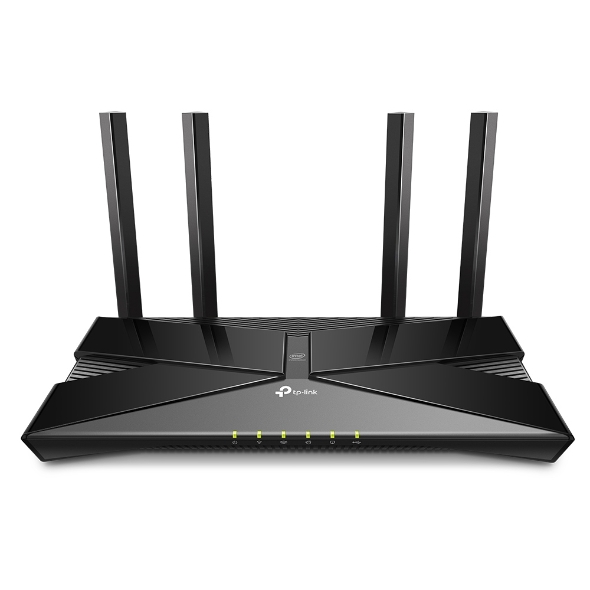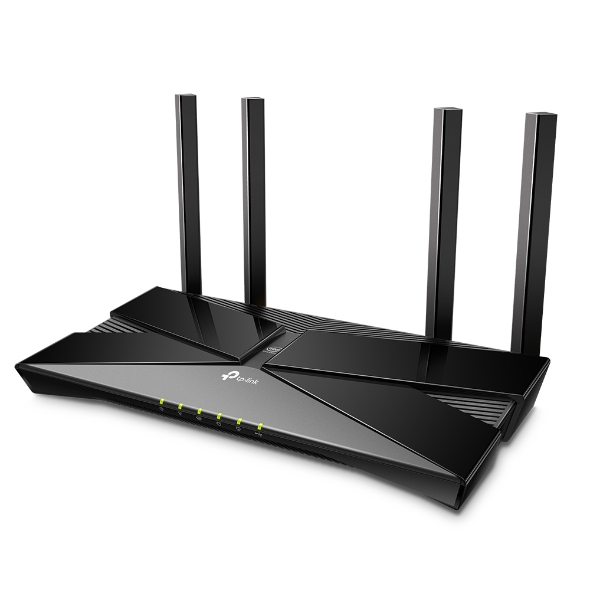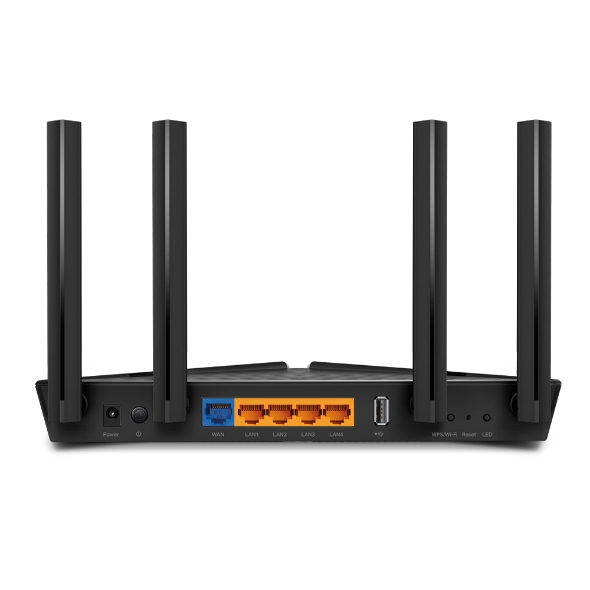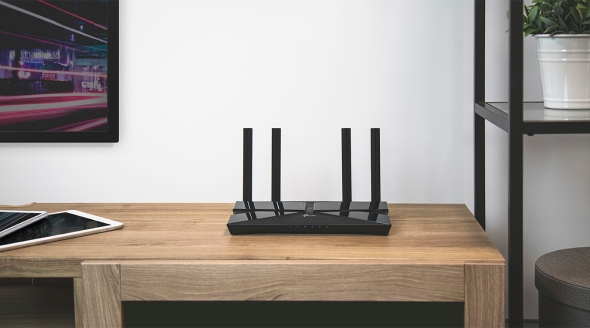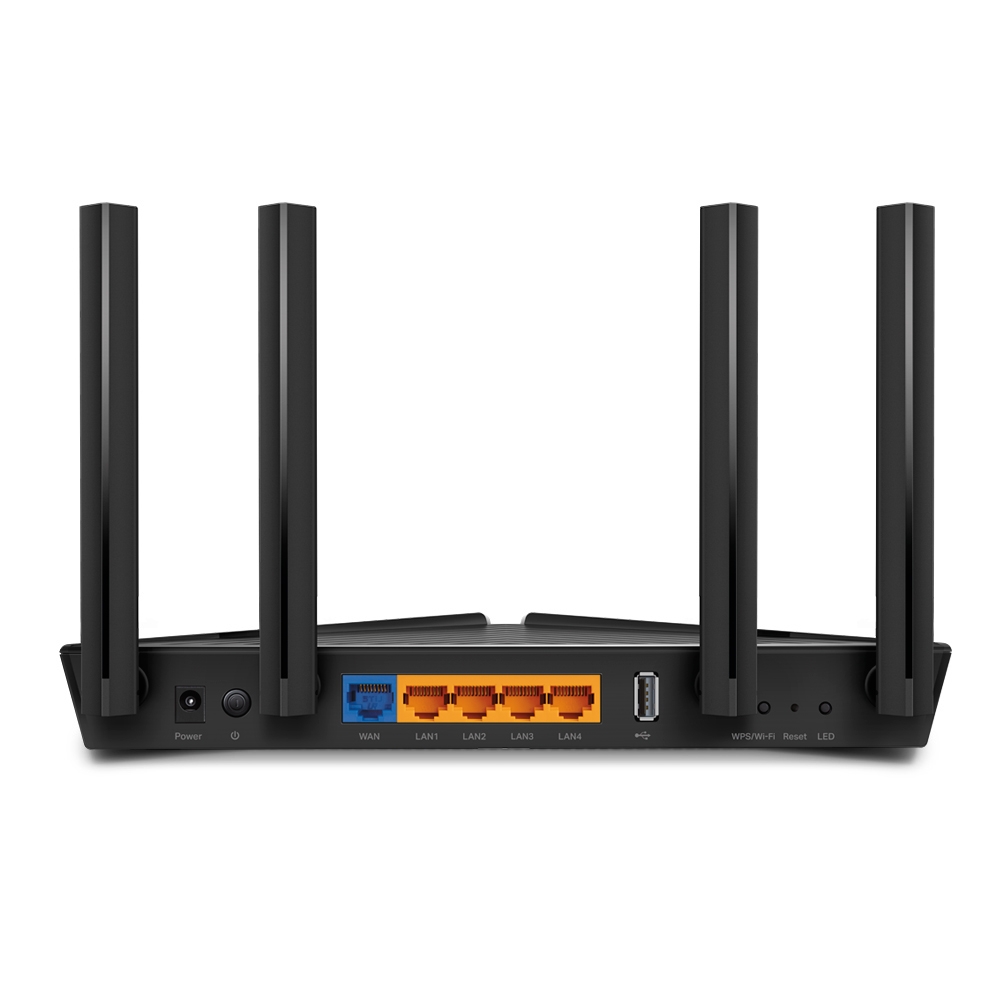Archer AX3000
AX3000 Dual Band Gigabit Wi-Fi 6 Router
- Wi-Fi 6 Technology Featuring Intel: Wi-Fi 6 technology achieves up to 3x faster speeds, higher capacity and lower latency compared to the previous generation of Wi-Fi 5 while the power of Intel's dual-core CPU ensures your experience is smooth and buffer-free.*†
- Next-Gen 3 Gbps Speeds: Reaches incredible speeds up to 3 Gbps (2402 Mbps on 5 GHz band and 574 Mbps on 2.4 GHz band) for faster streaming and gaming like you have never experienced before.†
- Connect More Devices: Simultaneously communicate more data to more devices using revolutionary OFDMA technology.△
- Minimize Lag for All Devices and Applications: Experience ultra-smooth entertainment whether you are streaming 4K videos, gaming online, or even video chatting with up to 75% reduced lag.§
- More Reliable Coverage: Achieve the strongest, most reliable WiFi coverage with Archer AX3000 as it focuses signal strength to your devices using Beamforming technology and four antennas.
- Increased Battery Life for Devices: Target Wake Time technology reduces your devices' power consumption to extend their battery life.**
- Easy Setup: Set up your router in minutes with the powerful TP-Link Tether App
- Backward Compatible: Archer AX3000 supports all previous 802.11 standards and all WiFi devices
Faster Speeds. More Connected Devices.
Powered by Intel.
-
Wi-Fi 6
+ Intel -
Up to 3 Gbps Speeds
-
More Connected Devices
-
Boosted Coverage
-
Reduced Power Consumption
The Latest Wi-Fi 6 Technology Featuring Intel
Experience the latest Wi-Fi 6 technology, which delivers up to 3x faster speeds, higher capacity, and 75% lower latency to meet all your WiFi needs.† Intel’s powerful dual-core processor ensures your experience is smooth and buffer-free.*
Next-Generation WiFi Speeds Up to 3 Gbps
Archer AX3000 brings you incredibly fast dual-band speeds up to 3x faster than the previous AC generation of WiFi, perfect for vivid 8K/4K streaming, intense online gaming, and more.‡
More Devices. Less Congestion. Smarter Home.
A great smart home starts with a smarter router. Archer AX3000 uses OFDMA technology to organize the flow of data to talk to all your smart home, streaming and gaming devices while simultaneously reducing lag by up to 75%.§ △
More Reliable Coverage
Achieve the strongest, most reliable WiFi coverage with Archer AX3000 as it focuses signal strength to your devices using Beamforming technology and four antennas.
Reduced Power Consumption. Increased Battery Life.
Target Wake Time (TWT) talks to your devices and negotiates when and how frequently they should transfer data to increase device sleep time, extending battery life.**

Easily Set Up and Manage Your WiFi
Set up and manage your WiFi through the TP-Link Tether app (Android, iOS). Access WiFi settings such as parental controls, guest privileges and more right from your smartphone.
| WIRELESS | |
|---|---|
| Standards | Wi-Fi 6IEEE 802.11ax/ac/n/a 5 GHzIEEE 802.11ax/n/b/g 2.4 GHz |
| WiFi Speeds | AX30005 GHz: 2402 Mbps (802.11ax)2.4 GHz: 574 Mbps (802.11ax) |
| WiFi Range | 3 Bedroom Houses Antennas Multiple antennas form a signal-boosting array to cover more directions and large areas Beamforming Concentrates wireless signal strength towards clients to expand WiFi range High-Power FEM Improves transmission power to strengthen signal coverage |
| WiFi Capacity | High Dual-Band Allocate devices to different bands for optimal performance OFDMA Simultaneously communicates with multiple Wi-Fi 6 clients Airtime Fairness Improves network efficiency by limiting excessive occupation DFS Access an extra band to reduce congestion 4 Streams Connect your devices to more bandwidth |
| Working Modes | Router ModeAccess Point Mode |
| HARDWARE | |
|---|---|
| Processor | Dual-Core CPU |
| Ethernet Ports | 1× Gigabit WAN Port 4× Gigabit LAN Ports Static Link Aggregation (LAG) available with 2× LAN ports |
| USB Support | 1× USB 2.0 Port Supported Partition Formats: NTFS, exFAT, HFS+, FAT32 Supported Functions: Apple Time Machine FTP Server Media Server Samba Server |
| Buttons | Wi-Fi/WPS ButtonPower On/Off ButtonLED On/Off ButtonReset Button |
| Power | 12 V ⎓ 2 A |
| SECURITY | |
|---|---|
| WiFi Encryption | WEPWPAWPA2WPA/WPA2-Enterprise (802.1x) |
| Network Security | SPI Firewall Access Control IP & MAC Binding Application Layer Gateway |
| Guest Network | 1× 5 GHz Guest Network1× 2.4 GHz Guest Network |
| VPN Server | OpenVPNPPTP |
| SOFTWARE | |
|---|---|
| Protocols | IPv4IPv6 |
| Parental Controls | URL Filtering Time Controls |
| WAN Types | Dynamic IPStatic IPPPPoEPPTPL2TP |
| Quality of Service | QoS by Device |
| Cloud Service | Auto Firmware UpgradeOTA Firmware UpgradeTP-Link IDDDNS |
| NAT Forwarding | Virtual ServersPort ForwardingPort TriggeringDMZUPnP |
| IPTV | IGMP ProxyIGMP SnoopingBridgeTag VLAN |
| DHCP | Address ReservationDHCP Client ListServer |
| DDNS | TP-LinkNO-IPDynDNS |
| Management | Tether AppWebpageCheck Web Emulator> |
| PHYSICAL | |
|---|---|
| Dimensions (W×D×H) | 10.2 × 5.3 × 1.5 in(260.2 x 135.0 x 38.6 mm) |
| Package Contents | Wi-Fi Router Archer AX3000Power AdapterRJ45 Ethernet CableQuick Installation Guide |
| OTHER | |
|---|---|
| System Requirements | Internet Explorer 11+, Firefox 12.0+, Chrome 20.0+, Safari 4.0+, or other JavaScript-enabled browserCable or DSL Modem (if needed)Subscription with an internet service provider (for internet access) |
| Certifications | FCC |
| Environment | Operating Temperature: 0℃~40℃ (32℉ ~104℉)Storage Temperature: -40℃~70℃ (-40℉ ~158℉)Operating Humidity: 10%~90% non-condensingStorage Humidity: 5%~90% non-condensing |
| TEST DATA | |
|---|---|
| WiFi Transmission Power | FCC: <30dBm(2.4GHz & 5.15GHz~5.825GHz) |
| WiFi Reception Sensitivity | 5 GHz:11a 6Mbps:-97dBm, 11a 54Mbps:-79dBm11ac VHT20_MCS0:-96dBm, 11ac VHT20_MCS11:-66dBm11ac VHT40_MCS0:-94dBm, 11ac VHT40_MCS11:-63dBm11ac VHT80_MCS0:-91dBm, 11ac VHT80_MCS11:-60dBm11ac VHT160_MCS0:-88dBm, 11ac VHT160_MCS11:-55dBm11ax HE20_MCS0:-95dBm, 11ax HE20_MCS11:-63dBm11ax HE40_MCS0:-92dBm, 11ax HE40_MCS11:-60dBm11ax HE80_MCS0:-89dBm, 11ax HE80_MCS11:-58dBm11ax HE160_MCS0:-85dBm, 11ax HE160_MCS11:-55dBm2.4 GHz:11g 6Mbps:-97dBm, 11a 54Mbps:-79dBm11n HT20_MCS0:-97dBm, 11n HT20_MCS7:-78dBm11n HT40_MCS0:-95dBm, 11n HT40_MCS7:-75dBm11ac VHT20_MCS0:-96dBm, 11ac VHT20_MCS11:-67dBm11ac VHT40_MCS0:-94dBm, 11ac VHT40_MCS11:-64dBm11ax HE20_MCS0:-96dBm, 11ax HE20_MCS11:-64dBm11ax HE40_MCS0:-93dBm, 11ax HE40_MCS11:-61dBm |
†Claims about 802.11ax Wi-Fi technology are based on comparisons of the expected maximum theoretical data rates for one spatial stream using 802.11ax at 160 MHz (1201 Mbps) as opposed to one spatial stream using 802.11ac at 80 MHz (433 Mbps) as documented in IEEE 802.11ax draft 3.0 spec and IEEE 802.11-2016 wireless standard specifications, and require the use of similarly configured 802.11ax wireless network routers.
Use of 802.11ax Wi-Fi standard requires clients to also support the 802.11ax Wi-Fi standard.
‡802.11ax 2x2 160MHz enables 2402Mbps maximum theoretical data rates, 3X faster than standard 802.11ac 2x2 80MHz (867Mbps) and nearly 6x faster than baseline 1x1ac (433Mbps) Wi-Fi as documented in IEEE 802.11 wireless standard specifications, and require the use of similarly configured 802.11ax wireless network routers.
§ Up to 75% lower latency” is based on Intel simulation data of 802.11ax with and without OFDMA using 9 clients. Average latency without OFDM is 36ms, with OFDMA average latency is reduced to 7.6ms. Latency improvement requires that the AP and all clients support OFDMA.
***Capacity refers to overall average throughput. This amendment defines standardized modifications to both the IEEE 802.11 physical layers (PHY) and the IEEE 802.11 Medium Access Control layer (MAC) that enable at least one mode of operation capable of supporting at least four times improvement in the average throughput per station (measured at the MAC data service access point) in a dense deployment scenario, while maintaining or improving the power efficiency per station.
*Intel and the Intel logo are trademarks of Intel Corporation or its subsidiaries in the U.S. and/or other countries.
**Saving clients' battery power requires clients to also support the 802.11ax Wi-Fi standard. Actual power reduction may vary as a result of network conditions, client limitations, and environmental factors.
△Use of OFDMA requires clients to also support OFDMA
This router may not support all the mandatory features as ratified in Draft 3.0 of IEEE 802.11AX specification.
